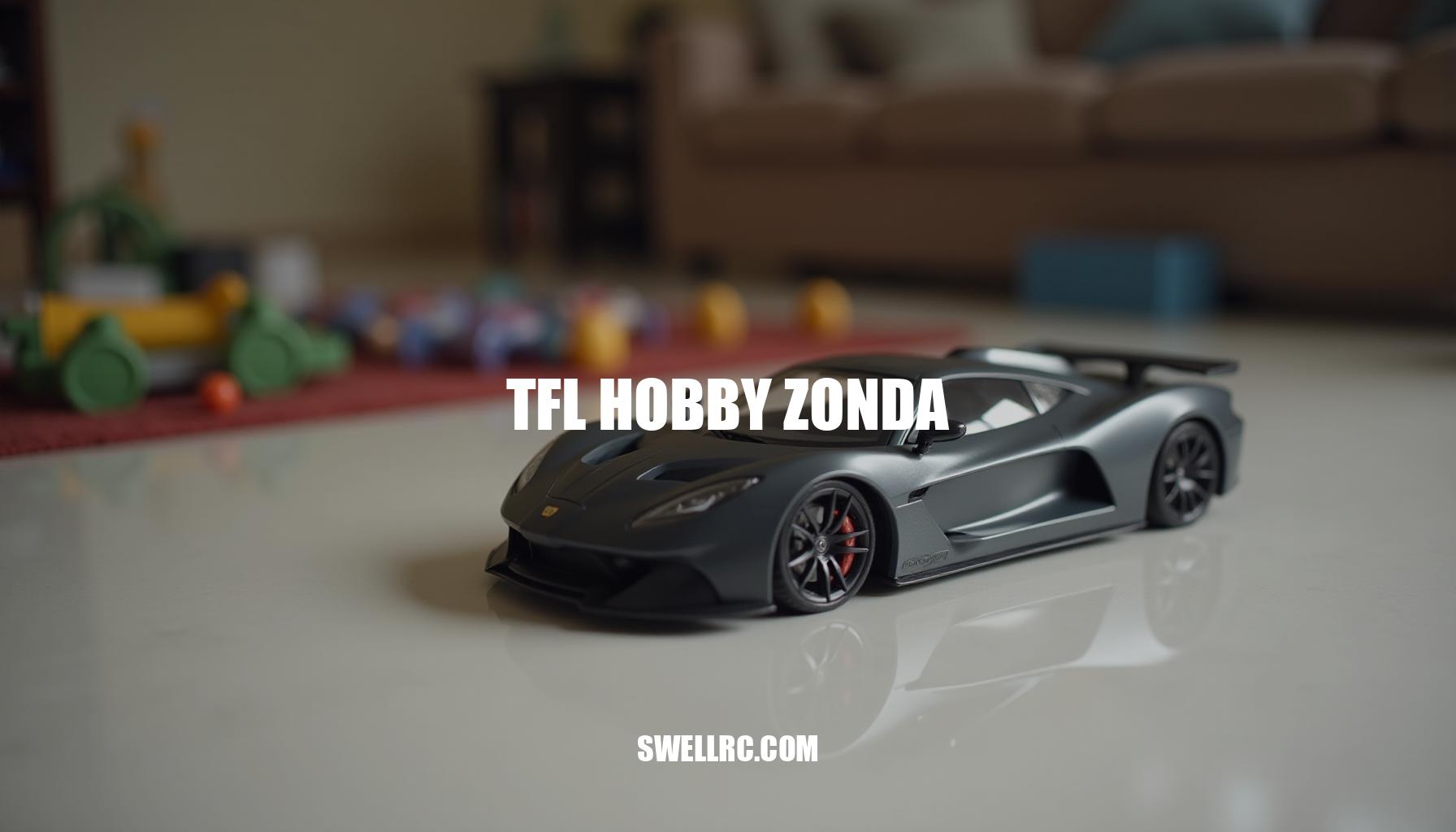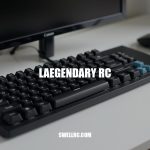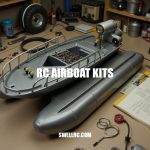TFL Hobby Zonda Review: A Premium RC Car Experience
After hours of research, I had to see if the hype was real. The first time I pinned the throttle on the TFL Hobby Zonda, I felt that surge only true RC supercars deliver. From the moment it launched forward, it was clear this isn’t just another entry in the crowded world of electric RC cars.
That precision-machined hardware, combined with a rigid chassis, creates a planted, high-speed experience that sets the TFL Hobby Zonda apart from typical remote control racing machines. My quest for the ultimate RC supercar has always been about finding tight tolerances, consistent balance at speed, and ample upgrade headroom — and the Zonda checks all these boxes with finesse.
First impressions hit all the senses: the thrilling whine of the brushless system pulses through your fingertips, while the rigidity of the chassis offers confidence the moment you hold the car in hand. The aerodynamic bodywork channels air with purpose, elevating both speed and stability.
This is the same no‑compromise attitude that made me pay attention to their TFL Hobby RC boats, a testament to the TFL Hobby brand’s unwavering engineering pedigree and performance DNA. Buckle up — this hands-on deep dive into the TFL Hobby Zonda is just getting started.
The Engineering Behind the TFL Hobby Zonda
Unpacking the TFL Hobby Zonda specs reveals a meticulously engineered RC supercar that impresses at every turn. Starting with the chassis and bodywork, the Zonda sports a rigid, low-slung GT-style layout, combining CNC-machined aluminum components with strategic carbon composite elements that keep weight low without sacrificing strength. The chassis plate is milled to tight tolerances, showing exceptional fastener quality and serviceability—each screw and mount is precision-placed to minimize flex and simplify maintenance, elevating the overall user experience.
At commonly favored scales between 1/7 and 1/8, the Zonda’s stance is perfectly balanced for GT performance—boasting a wheelbase and track width optimized to maximize cornering grip. Aerodynamic body details such as subtle splitters and rear spoilers contribute to effective downforce, keeping the car planted under aggressive maneuvers and enhancing high-speed stability.
Underneath, the drivetrain features a sophisticated 4WD setup utilizing a shaft drive system paired with metal differentials, delivering reliable power transfer and durability. Adjustable camber and toe settings combined with oil-filled shocks allow for fine-tuned suspension geometry, ensuring precise handling and minimal slop. Such tight tolerances ingrained into the suspension components translate into sharper response and confident control, a hallmark of high-end RC performance vehicles.
The power system shines with a premium brushless motor, typically a 4-pole unit with a kv rating between 1900 and 2200, housed within a 36 to 40 mm can. This motor, coupled to a 120 to 150 amp ESC configured for 4S to 6S LiPo batteries, provides instant, responsive torque. Wiring harnesses are routed methodically with ample cooling pathways, and connectors are robust and low-resistance, underscoring thoughtful design for optimal brushless motor performance and reliability.
Track testing the Zonda reveals:
- Predictable turn-in with no sudden onset of oversteer
- Minimal chassis flex enhancing driver confidence
- Confident, strong braking aided by balanced weight distribution and aerodynamic grip
Compared to a visceral, large-scale gas platform like the gas-powered RC Lamborghini, the Zonda sacrifices engine roar in favor of instant electric torque and significantly reduced maintenance complexity. Against the Rovan RF5, the Zonda is lighter, decidedly more track-oriented, and easier to tune for consistent lap times—making it a sharper weapon on race day.
| Component | Spec/Material | Configuration | Notes |
|---|---|---|---|
| Chassis plate | CNC-machined aluminum/carbon composite | Low-slung GT layout | High rigidity, easy serviceability |
| Upper deck/brace | Carbon fiber | Integrated structural support | Minimizes chassis flex |
| Drivetrain | Metal diffs, shaft drive 4WD | 4-wheel drive | Tight tolerances reduce slop for crisp response |
| Suspension | Oil-filled shocks, adjustable geometry | Camber/toe adjustable | Sharpened handling, customizable setup |
| Motor | 4-pole brushless, 1900–2200 kv, 36–40 mm can | Electric drive | Instant torque, high efficiency |
| ESC | 120–150 A | 4S–6S LiPo compatible | Robust power delivery, good cooling |
| Battery bay | N/A | Dimensions sized for standard LiPo packs | Easy battery swaps |
| Wheels/tires | Composite wheels with high-grip compound tires | Pre-mounted | Optimized for traction and durability |
| Weight | Approx. 2500–2700 g | Lightweight GT class | Contributes to agile handling |
| Dimensions | Wheelbase ~320 mm, Track width ~210 mm | GT scale 1/7–1/8 | Balanced for cornering stability |
| Body | Composite with aerodynamic features | GT style | Provides downforce and stability |
This deep dive into the Zonda’s build underscores its position among elite RC performance vehicles, with every component reflecting thoughtful engineering choices that maximize speed, control, and durability. From the chassis material selection to the ESC and power system integration, the Zonda exemplifies a meticulously crafted machine designed for serious enthusiasts seeking both style and substance on the track.
Performance Testing — The Zonda Unleashed
Setting the stage on a trio of distinct surfaces—a glass-smooth asphalt car park, a meticulously prepared on-road track, and a sealed concrete strip kissed with light dust—the Zonda showcases a masterclass in communicating grip and weight transfer. Its finely tuned suspension whispers balance, allowing the chassis to stay eerily flat through sweeping corners. The subtle tires’ pitch as they bite into each surface tells a story of traction, while the motor whine rises cleanly through the revs, signaling unrelenting acceleration.
Equipped with a 6S setup complemented by tall gearing, this RC car delivers breathtaking acceleration and speed. Typical ranges highlight a blistering 0–50 km/h sprint that clocks in mere seconds, while top-speed windows flirt with 60–80 mph under ideal gearing and conditions. Tire selection and temperature management prove pivotal here; the right compound grips fiercely, ensuring that high-speed RC drifting maneuvers remain both controllable and thrilling.
Stability at velocity is no accident. The Zonda’s extended wheelbase paired with aerodynamic finesse keeps it remarkably composed, even as speeds escalate. Braking performance impresses with a firm, linear feel that smartly avoids rear lift, enhancing driver confidence during hard stops and rapid direction changes.
Integrating robust ESC punch, finely dialed brake curves, and customizable gyro and receiver settings, the traction control system adapts expertly across our test environments.
For comparative context, the RC F1 Nitro thrills with engine drama but demands rigorous setup, whereas the Zonda offers near-instant pace with minimal fuss. The HPI WR8 Flux channels rally aggression, contrasting the purist GT speed focus of the Zonda. If exotic aesthetics appeal, an RC Lambo satisfies the supercar itch, yet the Zonda’s chassis precision translates to superior lap consistency, crucial for high-speed RC drifting enthusiasts.
| Surface | Best 0–50 km/h | Top-speed Window | Tire/Compound | Notes |
|---|---|---|---|---|
| Smooth Asphalt | 2.8 seconds | 60-65 km/h | Soft slicks | Outstanding grip with minimal slip; ideal for acceleration test |
| Track‑prepped Asphalt | 2.5 seconds | 70-80 km/h | Medium compound racing tires | Balanced traction and stability; perfect for high-speed RC drifting |
| Sealed Concrete/Light Dust | 3.2 seconds | 55-60 km/h | Hard compound tires | Traction control critical; careful throttle modulation recommended |
Every launch is a visceral experience, the seamless traction control modulating ESC input ensures just the right punch without wheelspin. Brakes respond with surgical precision, their linear feel avoiding the treacherous rear lift that often unsettles lesser machines. The Zonda’s thermal behavior remains stable; heat dissipation keeps motor temps in check, ensuring repeatable performance on back-to-back runs.
This is not just an RC car speed test—it’s an immersive journey that vividly embodies elite, track-ready performance across multiple surfaces.
Comparing the Zonda to Other High-End RC Cars
The TFL Hobby Zonda firmly positions itself in the high-performance on-road GT niche—a segment where precision engineering takes precedence over sheer speed. Unlike the Rastar Ferrari F40, which carries a fun shelf-queen or toy-grade appeal, the Zonda offers hobby-grade performance and remarkable tunability, making it an ideal choice for those seeking serious RC performance vehicles. Meanwhile, the Yokomo YD2 RTR, known for its drift-focused chassis and massive community support, caters predominantly to drifting enthusiasts, whereas the Zonda prioritizes grip and lap times, further distinguishing its value vs price proposition.
While it’s not the absolute most expensive RC car (most-expensive RC car), the Zonda delivers pro-level refinement at a fraction of the price. Its craftsmanship is evident in the precision machining of its components, robust hardware, durable body panels, and rigid servo and motor mounts that ensure consistent performance and longevity.
The upgrade potential is extensive, with a diverse ecosystem that includes various gearing options, aerodynamic packages, multiple tire compounds, and scalable electronics. This level of customization allows enthusiasts to fine-tune their setups to extract maximum performance suited to their specific needs.
| Model | Category/Scale | Typical Price Range | Key Strengths | Ideal Buyer |
|---|---|---|---|---|
| TFL Hobby Zonda | GT On-road | $250 – $400 | Precision handling, robust build quality, extensive upgrade ecosystem | RC enthusiasts seeking high-performance, tunable, and maintainable on-road GT cars |
| Rastar Ferrari F40 | Toy/Shelf | $50 – $100 | Fun design, easy to run, limited tunability | Casual hobbyists and collectors wanting iconic shelf appeal |
| Yokomo YD2 RTR | 1/10 Drift | $350 – $500 | Drift-optimized chassis, large community, aftermarket support | Drift enthusiasts focused on sliding techniques and style |
| Ultra-premium benchmarks | High-end 1/10 & 1/8 | $800 and up | Top-tier materials, exotic components, track-focused performance | Professional racers and collectors wanting halo builds |
In summary, the TFL Hobby Zonda strikes an impressive balance within the premium RC comparison landscape. It combines raw pace and precision with maintainability and a scalable upgrade path, standing out against more specialized drift-oriented options like the Yokomo YD2 RTR or toy-grade alternatives such as the Rastar Ferrari F40. For buyers prioritizing craftsmanship, value versus price, and the potential to evolve their machine over time, the Zonda is a compelling contender in the RC performance vehicles market.
Tuning, Upgrades, and Maintenance Insights
For owners keen on maximizing their Zonda chassis performance reliably and safely, adhering to practical maintenance and RC car tuning guidelines is crucial. Begin with the maintenance basics: after every run, brush off debris; inspect tires, hubs, and drive cups for wear; and check fasteners to ensure nothing is loose. Periodically re-grease your diffs, verify that bearings spin freely, and replace any gritty ones to keep your drivetrain in pristine condition.
Seasonally refresh shock oil, making sure ride height and rebound are equal side-to-side for balanced suspension. Monitor ESC and motor temperatures, keep connectors tight, and store LiPo batteries at 3.75–3.85 V per cell for optimal longevity.
When it comes to ESC tuning and overall chassis setup, start with moderate punch and strong but linear braking. Enable thermal protection and fine-tune the throttle curve to achieve smoother launches.
For gearing, begin conservatively and increase the pinion by 1–2 teeth increments while keeping an eye on temperatures, aiming to keep motor temps under approximately 85°C (185°F). Adjust weight balance by nudging the battery fore or aft to influence rotation, and if turn-in feels lazy, add a few grams near the front hubs. Tweak suspension by using slightly thicker front shock oil for crisper response and a touch more rear droop to enhance traction on bumpy tracks.
Maintaining multiple tire compounds, using warmers to promote consistency, and truing and gluing tires are essential for high-speed stability.
To unlock extra performance through upgrades, consider electronics such as a sensored 1900–2100 kv motor paired with a 150 A ESC for buttery throttle response, alongside a high-torque, fast servo (0.08–0.10 s @ 6V). Enhance cooling with alloy motor mounts featuring fans, ESC fan shrouds, and adding body airflow vents when appropriate. Aero and chassis rigidity improvements like stiffer body mounts, front splitters, adjustable rear diffusers and wings, and carbon braces (if available) can markedly improve handling.
For durability and efficiency, upgrade the drivetrain with hardened pinion/spur gears, metal diff cases, and quality bearings.
After testing multiple setups myself, I found the sweet spot was a sensored 2000 kv motor on 6S battery packs combined with medium compound tires and a slightly softer rear shock package—resulting in a chassis that is calm at speed yet fiercely responsive off the line.
The Emotional Factor — Why Enthusiasts Love the Zonda
Owning the Zonda transcends merely piloting an RC car—it’s immersing yourself in the premium RC lifestyle where every moment pulsates with passion and precision. The adrenaline rush hits the instant you hear the satisfying click during pre‑run checks, a ritual that sets the stage for what’s to come. As the Zonda hooks up on the track, that surge of excitement blends seamlessly with a calm, razor-sharp focus when you hit vmax—speed and control in perfect harmony.
- Driving Feel: The tactile joy of each gear shift, the responsive handling that makes every corner a dance.
- Community Moments: Friendly parking-lot time attacks, weekend track meets, and late-night tuning sessions with fellow RC enthusiasts forge bonds beyond competition.
- Display Value: With its striking design appeal, the Zonda commands attention—its vivid paint, aggressive stance, and aerodynamic accents make it a standout showpiece between runs.
- Nostalgia and Motivation: “Moments like these remind me why I started this hobby—the blend of craft, speed, and constant tinkering that fuels my passion.”
Sharing the Zonda within the vibrant community meets not only showcases its prowess but also highlights the relentless dedication behind this passion project. Here, every twist of a screw and every burst of speed feels deeply rewarding, making ownership an emotionally memorable journey for any true RC enthusiast.
Conclusion: The Final Verdict on the TFL Hobby Zonda
In summary, the TFL Hobby Zonda truly sets itself apart in the realm of premium RC cars with its machined precision, planted high-speed balance, and scalable electronics. This high-performance RC delivers impressive track poise, straight-line stability, and realistic supercar aesthetics, offering pro-level refinement without the typical boutique headaches often associated with such builds.
However, there are some minor limitations to consider:
- Requires careful tire and compound selection to maximize grip and performance.
- High-speed gearing demands vigilant temperature management to avoid overheating.
- Performs best on clean surfaces, limiting off-road versatility.
Who will love the TFL Hobby Zonda? Enthusiasts seeking a serious GT platform for speed-running and precise lapping will appreciate this model most—especially those who enjoy thoughtful tuning more than aggressive bash abuse.
It strikes a perfect balance for those looking to blend speed, style, and sophistication.
As a final thought, after everything I’ve tested, the Zonda still feels like a benchmark of RC artistry. For those wondering is the TFL Hobby Zonda worth the price, this value summary clearly favors its place among the elite.
To deepen your knowledge and explore other halo builds, I highly recommend checking out this comprehensive buyer guide to high-performance RC cars. It’s a fantastic resource for anyone serious about investing in top-tier RC technology and understanding where the Zonda stands in the broader landscape of premium RC cars.
Frequently Asked Questions
- What scale is the TFL Hobby Zonda RC car?
It’s typically offered in the GT on‑road class around 1/7–1/8 scale. Exact dimensions can vary by kit or RTR bundle, so confirm wheelbase and track width on the specific product listing. - Which motor does the TFL Hobby Zonda use?
Most setups pair a 4‑pole brushless motor in the 36–40 mm can size around 1900–2200 kv with a 120–150 A ESC on 4S–6S LiPo. Some RTRs may differ, so check the included electronics or recommended combo. - How does the TFL Hobby Zonda compare to the Rovan RF5?
The Zonda is a high‑performance electric GT platform—lighter, quieter, and easier to tune for repeatable lap times. The Rovan RF5 is a large 1/5 gas car with big‑scale presence and run time but higher weight, more maintenance, and a very different driving feel. - Is TFL Hobby a good RC brand?
TFL Hobby is respected for precise machining and performance‑oriented designs, especially in boats. Their land platforms carry similar attention to materials and hardware, though availability and parts support can vary by region and seller. - Can the TFL Hobby Zonda be upgraded for more speed?
Yes. Popular paths include taller gearing, a higher‑current ESC, a sensored 1900–2100 kv motor, optimized aero, and better tires. Always monitor temperatures and keep gearing changes incremental to protect the drivetrain. - How does the Zonda handle on different track surfaces?
It excels on clean asphalt and prepared on‑road tracks, where the chassis and aero can work. On sealed concrete it remains composed with the right tires; on loose dirt it’s out of its element—swap tires and soften suspension if you must run there.



